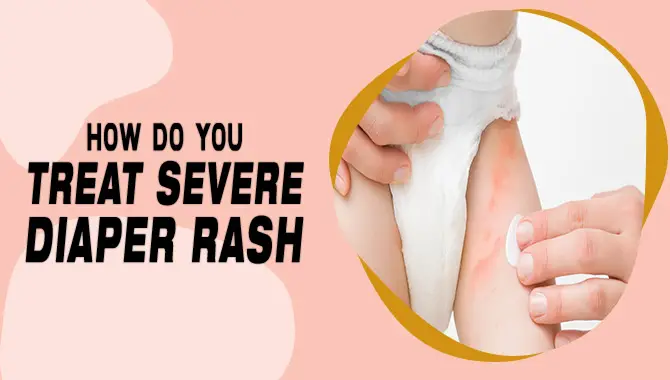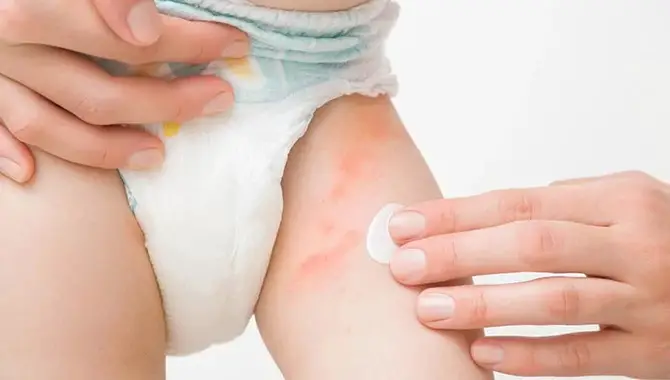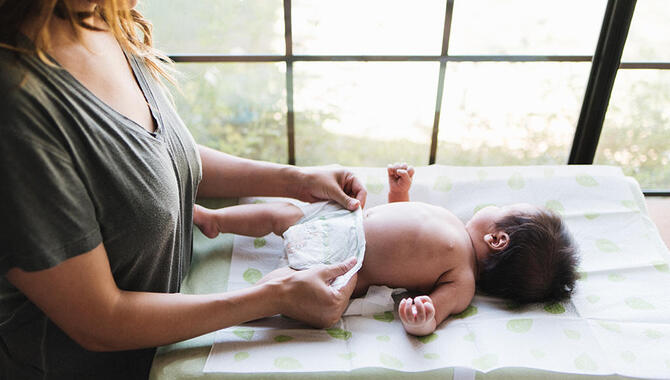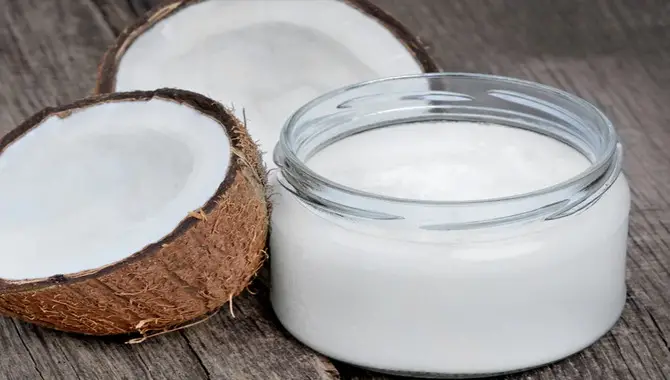Diaper rash can be frustrating for parents and become even more troubling if the rash is severe or chronic.
This is largely because diaper rash is often linked to underlying conditions such as eczema, thrush, and yeast infection. These conditions require different approaches to manage them effectively. First, it is important to identify the underlying cause of the rash (if known) and treat it appropriately. Diaper rash occurs when a baby’s sensitive skin is irritated by the wetness, friction, and chafing caused by the diaper.
Newborns are especially prone to developing diaper rash due to their delicate skin. It is a common and often uncomfortable condition for your baby. Thankfully, treating diaper rash can be simple if you follow a few easy steps. We will delve into the root cause of diaper rash, risk factors, and, most importantly, five simple tips to treat severe diaper rash at home.

What Is Diaper Rash?
Diaper rash is a common problem in infants and young children, which develops in the area beneath a diaper. It is mainly caused by prolonged exposure to pee or poop or excessive moisture. You can identify diaper rash by the red and inflamed patchwork on a baby’s bottom or genital area. Four common types of diaper rash are irritant, candida, bacterial, and allergic reaction diaper rash.
Treating diaper rash usually involves keeping the affected area dry and clean, changing the diaper frequently, and using a barrier cream. You can also use rash diaper creams to help soothe the affected area. If the diaper rash is severe, seeing a pediatrician or a healthcare provider is highly recommended.
5 Simple Tips To Treat Severe Diaper Rash

If your baby has developed a severe diaper rash, some simple solutions can help soothe and heal their delicate skin. In the event of a diaper rash, you should first try to identify the cause of the rash. Perhaps your baby is allergic to a common ingredient in diaper cream or has a sensitive skin condition like eczema.
In such cases, you can use a hypoallergenic diaper cream or emollient-free products. You can also try oatmeal soap, which helps with redness and irritation. It also helps prevent infections by drying out the area. Here are 5 simple tips to help you treat severe diaper rash:
1. Could You Keep It Clean And Dry

Keeping a diaper rash under control with clean and dry treatment is important. Keeping the area clean and dry helps keep the rash away by reducing moisture in the skin. Moisture attracts bacteria, which can cause an infection and lead to further irritation.
To keep a diaper rash under control, you should use a mild detergent or soap-free wash for normal cleaning. Dry the area well with a towel or air-dry it after washing. It is also important to use soft cloth diapers or reusable nappies designed for sensitive skin, like Pampers Sensitive Diapers.
These clothes do not contain harsh chemicals that can irritate the skin and help reduce redness and swelling in the diaper area. You can also use a moisturizing cream or ointment for additional relief from diaper rash. If you notice any redness, swelling, or pus, seek medical attention as soon it possible to avoid spreading the infection to your baby’s bottom.
2. Change Diapers Often

One of the most important steps in treating severe diaper rash is to change diapers frequently. Diapers should be changed immediately, even if they are only slightly wet. This is important because moisture can contribute to the growth of bacteria and yeast, which can worsen a diaper rash. It’s also important to change superabsorbent disposable diapers when they are wet.
In addition to changing diapers often, it’s best to avoid using baby powder and talc as a barrier against moisture, as these products can irritate the skin further. Instead, consider using a diaper cream or ointment to create a protective barrier on the skin. By following these simple tips, you can help to effectively treat severe diaper rash and keep your baby’s skin healthy and irritation-free.
3. Switch To Disposable Diapers

If your baby is experiencing severe diaper rash, consider switching to disposable diapers for a brief period. Disposable diapers are designed to absorb moisture quickly and keep bottoms dry, which can help reduce the risk of a rash. Additionally, disposable diapers have a hard surface that helps distribute the pressure and reduce the friction on the baby’s skin.
While reusable cloth diapers can be good for the environment, they may not necessarily be the best option for babies with severe diaper rash. Switching to disposable diapers for a short period can help reduce irritation and give your baby the relief they need to heal. Remember to change the diapers frequently and use a mild detergent for normal cleaning.
4. Check The Size Of Your Child’s Diaper

Several simple solutions help alleviate discomfort and promote healing when dealing with severe diaper rash. One important tip is to check the size of your child’s diaper. If the diaper is too small, it may not properly absorb urine, leading to skin irritation, rashes, and infection.
Similarly, an overly tight diaper can cause irritation and friction. To prevent severe diaper rash, use the correct size diaper for your child and change it frequently. If your child’s diaper rash is severe, it’s best to consult with a doctor for further treatment options.
5. Apply Soothing Creams

Severe diaper rash can be a painful and uncomfortable experience for both babies and their caregivers. However, several simple tips can help treat this condition. One of the most effective treatments is to apply a thick layer of mild hydrocortisone cream, antifungal cream, or another ointment to soothe the affected area. Additionally, it’s important to avoid using baby wipes and opt for scent-free, natural wipes to reduce irritation.
When introducing new foods to your baby’s diet, it’s important to do so cautiously as acidic foods can cause diaper rash. To help heal and prevent future occurrences of diaper rash, try DESITIN® ointment, specifically formulated to protect and heal delicate baby skin. Finally, keep the diaper area clean and dry to reduce irritation and promote healing.
Consider Alternative Soothing Remedies

Severe diaper rash can be a nightmare for parents, but several simple tips can help treat the condition. Firstly, it is important to keep the area clean and dry. Regularly changing dirty diapers and gently cleaning the area with a soft cloth can help prevent further irritation.
Consider alternative soothing remedies such as aloe vera gel, calendula cream, witch hazel ointment, shampoo clay, or breast milk. These natural remedies can help soothe the skin and reduce inflammation. For worse cases, you can use mild hydrocortisone cream twice daily for 3 to 5 days.
However, it is important to consult a doctor before using any medication on a baby’s delicate skin. Parents should ensure the skin is dry, clean, and protected from further irritation to get the best results. If the rash persists even with prescription products, it may be time to see a skin specialist (dermatologist) for further treatment options.
Shop For Diaper Rash Creams
If your baby is suffering from severe diaper rash, there are a few simple tips you can follow to help relieve the discomfort. Firstly, change diapers more frequently and clean the affected area thoroughly before applying diaper rash creams. You can try two popular creams, Triple Paste and A+D Ointment, which you can purchase online.
In addition to creams, several natural baby products can help treat diaper rash. Burt’s Bees Original Baby Nourishing Lotion, Baby Bee Nourishing Baby Oil, Aloe Vera Gel, Weleda Diaper Cream, and Earth Mama Organics Sweet Orange Baby Lotion are great options.
Proper care and treatment can clear most diaper rashes within 2-3 days.
However, if the rash persists or becomes more severe, it’s important to consult with a pediatrician to rule out any underlying infections or conditions.
Avoid These Products
When it comes to treating severe diaper rash, there are a few simple tips that can help alleviate discomfort and promote healing. One important tip is to avoid certain products that may worsen the rash. You should avoid baby wipes with alcohol or fragrance as they can irritate the skin.
Additionally, powders or cornstarch should not be used, as they can be inhaled and cause respiratory issues. Ointments containing boric acid, camphor, phenol, methyl salicylate, or a compound of benzoin tincture should also be avoided.
Instead, use unscented soaps and detergents when washing the diaper area, and avoid scrubbing or rubbing the area when cleaning, as it can further irritate the rash. These simple tips can go a long way in treating severe diaper rash and preventing further discomfort for your little one.
What Causes Diaper Rash?
Diaper rashes can be caused by various factors, including prolonged exposure to wet diapers, moisture, bacteria, and even certain allergies. Urine and feces break down in a diaper quickly, creating an environment that leads to diaper rash.
Moreover, the overgrowth of a fungus called candida yeast can also cause diaper rash in infants. In rare cases, diaper rash may be caused by bacteria such as staph or strep. Allergic reactions to materials such as diapers or wipes and certain diaper creams can also cause diaper rash.
Other factors, such as sleeping through the night with fewer diaper changes or transitioning from baby food to solid food, can also trigger diaper rash. Thus, keeping babies clean and dry and changing their diapers frequently can help prevent diaper rash.
Are There Risk Factors For Diaper Rash?
Diaper rash is most commonly found in babies between 4 to 15 months of age, and several factors can lead to a more severe case. For instance, not changing the diaper frequently enough or leaving a diaper on for long periods can contribute to the rash.
Other risk factors include transitioning from baby food to solid food, taking antibiotics, having diarrhea or a cold, and constant wetness and friction caused by frequent movement. Furthermore, some babies may be allergic to diapers, wipes, or soaps.
Overusing topical steroids and certain diapers can also cause diaper rash. Determining the cause behind the rash and eliminating any potential triggers is crucial. Proper treatment and care and identifying and addressing the underlying causes can significantly help manage and treat diaper rash.
Conclusion
It is important to consider the condition’s underlying cause in treating severe diaper rash. This can help in determining the appropriate treatment. Various therapies effectively treat diaper rash, including topical creams, ointments, and suppositories.
Before treating the rash, it is important to consider any underlying conditions, such as irritable bowel syndrome or yeast infection. In addition to medication therapy, it is essential to maintain good hygiene and change diapers frequently to prevent further damage.
Severe diaper rash is a painful condition that requires prompt treatment. Keeping your baby’s skin clean and dry, changing diapers frequently, using the right size diaper, avoiding certain products, and applying soothing creams are just a few ways to help minimize the risk of severe diaper rash. You can also try alternative remedies, such as a warm or oatmeal bath to soothe the skin. These simple steps can help prevent diaper rash and keep your baby happy and healthy.
Frequently Asked Questions
How Do You Change A Child’s Diaper On A Plane?
To change a child’s diaper on a plane, ensure you have all the necessary supplies, including a clean diaper, wipes, and a changing pad. Check if the plane has a designated changing table in the restroom.
If there is no changing table, consider using the top of the closed toilet seat as a changing surface. Secure your child safely with the seatbelt or arm while changing the diaper.
Can You Change A Diaper On An Airplane Seat?
Yes, you can change a diaper on an airplane seat, but it is not recommended. Airplanes typically have designated changing tables in the lavatory that is cleaner and more sanitary. If it is necessary to change a diaper in your seat, bring a changing pad, wipes, and a bag for disposal. Respecting other passengers and cleaning up any mess afterward is also important.
Do Airplanes Have Changing Tables For Babies?
It depends on the airline and the aircraft type, but many airplanes have to change tables in the restrooms specifically designated for baby care purposes. However, checking with the airline before traveling is always a good idea to ensure that their planes have to change the tables available.
What Do You Do If Your Baby Poops On A Plane?
If your baby poops on a plane, don’t panic. First, try to stay calm and clean up your baby as best as possible using wipes and a clean diaper.
If the situation requires it, you can ask the flight attendants for assistance, who are typically equipped with supplies such as plastic bags and spare clothing. Bringing extra diapers, wipes, and clothing when traveling with a baby is always a good idea to ensure you are prepared for any situation.
What Is The Best Way To Change A Diaper On A Plane?
The best way to change a diaper on a plane is to go to the bathroom and use the changing table, if available. Before you start, ensure you have all the necessary supplies, including diapers, wipes, and a plastic bag for soiled items.
If the changing table is occupied, ask a flight attendant for assistance or use the back rows of seats if the flight is not full. Make sure to clean up thoroughly and dispose of all waste properly.


Im a 70 year old male and due to having diaper rash once in a great while i get a case of diaper rash and i have to go to my doctor to get special creme to get rid of it and some times i have to go on steroids to get rid of it because i have diabetes.A nd over the counter creme doesnt work for me b ut useing at creme that at least to get rid of the itch i would recommend useing a topical creme for it with a anti itch solution in it. Ken Koboski